541418e6165596e9dc4268f7517a81b6.ppt
- Количество слайдов: 144

Molecular phylogeny Computer lab December 11, 2009 Genomics J. Pevsner pevsner@kennedykrieger. org

Five kingdom system (Haeckel, 1879) mammals vertebrates animals invertebrates plants fungi protists monera protozoa Page 516

Goals of the lab Introduction to evolution and phylogeny Nomenclature of trees Five stages of molecular phylogeny: [1] selecting sequences [2] multiple sequence alignment [3] models of substitution [4] tree-building [5] tree evaluation Practical approaches to making trees




Goals of the lecture Introduction to evolution and phylogeny Nomenclature of trees Five stages of molecular phylogeny: [1] selecting sequences [2] multiple sequence alignment [3] models of substitution [4] tree-building [5] tree evaluation Practical approaches to making trees

Introduction Charles Darwin’s 1859 book (On the Origin of Species By Means of Natural Selection, or the Preservation of Favoured Races in the Struggle for Life) introduced theory of evolution. To Darwin, the struggle for existence induces a natural selection. Offspring are dissimilar from their parents (that is, variability exists), and individuals that are more fit for a given environment are selected for. In this way, over long periods of time, species evolve. Groups of organisms change over time so that descendants differ structurally and functionally from their ancestors. Page 215

Introduction At the molecular level, evolution is a process of mutation with selection. Molecular evolution is the study of changes in genes and proteins throughout different branches of the tree of life. Phylogeny is the inference of evolutionary relationships. Traditionally, phylogeny relied on the comparison of morphological features between organisms. Today, molecular sequence data are also used for phylogenetic analyses. Page 216

Goals of molecular phylogeny Phylogeny can answer questions such as: • How many genes are related to my favorite gene? • Was the extinct quagga more like a zebra or a horse? • Was Darwin correct that humans are closest to chimps and gorillas? • How related are whales, dolphins & porpoises to cows? • Where and when did HIV originate? • What is the history of life on earth?

Molecular phylogeny in bioinformatics Many of the topics we have discussed so far involve explicit or implicit models of evolution. Dayhoff et al. (1978) describe scoring matrices: “An accepted point mutation in a protein is a replacement of one amino acid by another, accepted by natural selection. It is the result of two distinct processes: the first is the occurrence of a mutation in the portion of the gene template producing one amino acid of a protein; the second is the acceptance of the mutation by the species as the new predominant form. Page 217

Historical background Studies of molecular evolution began with the first sequencing of proteins, beginning in the 1950 s. In 1953 Frederick Sanger and colleagues determined the primary amino acid sequence of insulin. (The accession number of human insulin is NP_000198) Page 219

Mature insulin consists of an A chain and B chain heterodimer connected by disulphide bridges The signal peptide and C peptide are cleaved, and their sequences display fewer functional constraints. Fig. 7. 3 Page 220

Fig. 7. 3 Page 220

Note the sequence divergence in the disulfide loop region of the A chain Fig. 7. 3 Page 220

Historical background: insulin By the 1950 s, it became clear that amino acid substitutions occur nonrandomly. For example, Sanger and colleagues noted that most amino acid changes in the insulin A chain are restricted to a disulfide loop region. Such differences are called “neutral” changes (Kimura, 1968; Jukes and Cantor, 1969). Subsequent studies at the DNA level showed that rate of nucleotide (and of amino acid) substitution is about sixto ten-fold higher in the C peptide, relative to the A and B chains. Page 219

0. 1 x 10 -9 Number of nucleotide substitutions/site/year Fig. 7. 3 Page 220

Historical background: insulin Surprisingly, insulin from the guinea pig (and from the related coypu) evolve seven times faster than insulin from other species. Why? The answer is that guinea pig and coypu insulin do not bind two zinc ions, while insulin molecules from most other species do. There was a relaxation on the structural constraints of these molecules, and so the genes diverged rapidly. Page 219

Guinea pig and coypu insulin have undergone an extremely rapid rate of evolutionary change Arrows indicate positions at which guinea pig insulin (A chain and B chain) differs from both human and mouse Fig. 7. 3 Page 220

Molecular clock hypothesis In the 1960 s, sequence data were accumulated for small, abundant proteins such as globins, cytochromes c, and fibrinopeptides. Some proteins appeared to evolve slowly, while others evolved rapidly. Linus Pauling, Emanuel Margoliash and others proposed the hypothesis of a molecular clock: For every given protein, the rate of molecular evolution is approximately constant in all evolutionary lineages Page 221

Molecular clock hypothesis As an example, Richard Dickerson (1971) plotted data from three protein families: cytochrome c, hemoglobin, and fibrinopeptides. The x-axis shows the divergence times of the species, estimated from paleontological data. The y-axis shows m, the corrected number of amino acid changes per 100 residues. n is the observed number of amino acid changes per 100 residues, and it is corrected to m to account for changes that occur but are not observed. N = 1 – e-(m/100) 100 Page 222

corrected amino acid changes per 100 residues (m) Dickerson (1971) Millions of years since divergence Fig. 7. 5 Page 222

Molecular clock hypothesis: conclusions Dickerson drew the following conclusions: • For each protein, the data lie on a straight line. Thus, the rate of amino acid substitution has remained constant for each protein. • The average rate of change differs for each protein. The time for a 1% change to occur between two lines of evolution is 20 MY (cytochrome c), 5. 8 MY (hemoglobin), and 1. 1 MY (fibrinopeptides). • The observed variations in rate of change reflect functional constraints imposed by natural selection. Page 223

Molecular clock hypothesis: l and PAM The rate of amino acid substitution is measured by l, the number of substitutions per amino acid site per year. Consider serum albumin: l = 1. 9 x 10 -9 lx 109 = 1. 9 Dayhoff et al. (Box 3. 3, page 50) reported the rate of mutation acceptance for serum albumin as 19 PAMs per amino acid residue per 100 million years. (19 subst. /1 aa/108 years = 1. 9 subst. /100 aa/109 years) Page 223

Molecular clock for proteins: rate of substitutions per aa site per 109 years Fibrinopeptides Kappa casein Lactalbumin Serum albumin Lysozyme Trypsin Insulin Cytochrome c Histone H 2 B Ubiquitin Histone H 4 9. 0 3. 3 2. 7 1. 9 0. 98 0. 59 0. 44 0. 22 0. 09 0. 010 Table 7 -1 Page 223

Molecular clock hypothesis: implications If protein sequences evolve at constant rates, they can be used to estimate the times that sequences diverged. This is analogous to dating geological specimens by radioactive decay. Page 225

Positive and negative selection Darwin’s theory of evolution suggests that, at the phenotypic level, traits in a population that enhance survival are selected for, while traits that reduce fitness are selected against. For example, among a group of giraffes millions of years in the past, those giraffes that had longer necks were able to reach higher foliage and were more reproductively successful than their shorternecked group members, that is, the taller giraffes were selected for. In the mid-20 th century, a conventional view was that molecular sequences are routinely subject to positive (or negative) selection. Page 227

Positive and negative selection Darwin’s theory of evolution suggests that, at the phenotypic level, traits in a population that enhance survival are selected for, while traits that reduce fitness are selected against. For example, among a group of giraffes millions of years in the past, those giraffes that had longer necks were able to reach higher foliage and were more reproductively successful than their shorternecked group members, that is, the taller giraffes were selected for. Positive selection occurs when a sequence undergoes significantly increased rates of substitution, while negative selection occurs when a sequence undergoes change slowly. Otherwise, selection is neutral. Page 227

Tajima’s relative rate test in MEGA Page 228

Tajima’s relative rate test Page 228

A to B: known distance A to outgroup: known distance A to X: unknown (and solvable) B to X: unknown (and solvable) Question: is X-to-A the same length as X-to-B? X

Neutral theory of evolution An often-held view of evolution is that just as organisms propagate through natural selection, so also DNA and protein molecules are selected for. According to Motoo Kimura’s 1968 neutral theory of molecular evolution, the vast majority of DNA changes are not selected for in a Darwinian sense. The main cause of evolutionary change is random drift of mutant alleles that are selectively neutral (or nearly neutral). Positive Darwinian selection does occur, but it has a limited role. As an example, the divergent C peptide of insulin changes according to the neutral mutation rate. Page 230

Molecular phylogeny: nomenclature of trees There are two main kinds of information inherent to any tree: topology and branch lengths. We will now describe the parts of a tree. Page 231

Molecular phylogeny uses trees to depict evolutionary relationships among organisms. These trees are based upon DNA and protein sequence data. 2 A 1 I 2 1 1 G B H 2 1 6 1 2 C B 2 D C 2 1 E A 2 F D 6 one unit E time Fig. 7. 8 Page 232

Tree nomenclature taxon 2 A 1 I 2 1 1 G B H 2 1 6 1 2 C B 2 D C 2 1 E A 2 F D 6 one unit E time Fig. 7. 8 Page 232

Tree nomenclature operational taxonomic unit (OTU) such as a protein sequence taxon 2 A 1 I 2 1 1 G B H 2 1 6 1 2 C B 2 D C 2 1 E A 2 F D 6 one unit E time Fig. 7. 8 Page 232

Tree nomenclature branch (edge) Node (intersection or terminating point of two or more branches) 2 I 1 1 G B H 2 1 6 1 2 C B 2 D C 2 1 E A 2 F 1 2 A D 6 one unit E time Fig. 7. 8 Page 232

Tree nomenclature Branches are unscaled. . . 2 Branches are scaled. . . A 1 I 2 1 1 G B H 2 1 6 1 2 C B 2 D C 2 1 E A 2 F D 6 one unit E time …OTUs are neatly aligned, and nodes reflect time …branch lengths are proportional to number of amino acid changes Fig. 7. 8 Page 232

Tree nomenclature bifurcating internal node multifurcating internal node 2 A 1 I 2 1 1 G B H 2 1 6 A 2 F B 2 C 2 2 1 D E C D 6 one unit E time Fig. 7. 9 Page 233

Examples of multifurcation: failure to resolve the branching order of some metazoans and protostomes Rokas A. et al. , Animal Evolution and the Molecular Signature of Radiations Compressed in Time, Science 310: 1933 (2005), Fig. 1.

Tree nomenclature: clades Clade ABF (monophyletic group) 2 F 1 I 2 A 1 B G H 2 1 6 C D E time Fig. 7. 8 Page 232

Tree nomenclature Clade ABF/CDH/G 2 A F 1 I 2 1 G B H 2 1 6 C D E time Fig. 7. 8 Page 232

Examples of clades Lindblad-Toh et al. , Nature 438: 803 (2005), fig. 10

Tree roots The root of a phylogenetic tree represents the common ancestor of the sequences. Some trees are unrooted, and thus do not specify the common ancestor. A tree can be rooted using an outgroup (that is, a taxon known to be distantly related from all other OTUs). Page 233

Tree nomenclature: roots past 9 1 7 5 8 6 2 present 1 7 3 4 2 5 Rooted tree (specifies evolutionary path) 8 6 3 4 Unrooted tree Fig. 7. 10 Page 234

Tree nomenclature: outgroup rooting past root 9 10 7 8 7 6 2 present 9 8 3 4 1 Rooted tree 2 5 1 3 4 5 6 Outgroup (used to place the root) Fig. 7. 10 Page 234

Enumerating trees Cavalii-Sforza and Edwards (1967) derived the number of possible unrooted trees (NU) for n OTUs (n > 3): NU = (2 n-5)! 2 n-3(n-3)! The number of bifurcating rooted trees (NR) (2 n-3)! NR = n-2 2 (n-2)! For 10 OTUs (e. g. 10 DNA or protein sequences), the number of possible rooted trees is 34 million, and the number of unrooted trees is 2 million. Many tree-making algorithms can exhaustively examine every possible tree for up to ten to twelve sequences. Page 235

Numbers of trees Number of OTUs 2 3 4 5 10 20 Number of rooted trees 1 3 15 105 34, 459, 425 8 x 1021 Number of unrooted trees 1 1 3 15 105 2 x 1020 Page 235

Species trees versus gene/protein trees Molecular evolutionary studies can be complicated by the fact that both species and genes evolve. speciation usually occurs when a species becomes reproductively isolated. In a species tree, each internal node represents a speciation event. Genes (and proteins) may duplicate or otherwise evolve before or after any given speciation event. The topology of a gene (or protein) based tree may differ from the topology of a species tree. Page 238

Species trees versus gene/protein trees past speciation event present species 1 species 2 Fig. 7. 14 Page 238

Species trees versus gene/protein trees Gene duplication events species 1 speciation event species 2 Fig. 7. 14 Page 238

Species trees versus gene/protein trees Gene duplication events speciation event OTUs species 1 species 2 Fig. 7. 14 Page 238
![Five stages of phylogenetic analysis [1] Selection of sequences for analysis [2] Multiple sequence Five stages of phylogenetic analysis [1] Selection of sequences for analysis [2] Multiple sequence](https://present5.com/presentation/541418e6165596e9dc4268f7517a81b6/image-53.jpg)
Five stages of phylogenetic analysis [1] Selection of sequences for analysis [2] Multiple sequence alignment [3] Selection of a substitution model [4] Tree building [5] Tree evaluation Page 243

Stage 1: Use of DNA, RNA, or protein For some phylogenetic studies, it may be preferable to use protein instead of DNA sequences. We saw that in pairwise alignment and in BLAST searching, protein is often more informative than DNA (Chapter 3). Page 240

Stage 1: Use of DNA, RNA, or protein For phylogeny, DNA can be more informative. --The protein-coding portion of DNA has synonymous and nonsynonymous substitutions. Thus, some DNA changes do not have corresponding protein changes. Page 240

Fig. 7. 16 Page 241

Fig. 7. 16 Page 241

Stage 1: Use of DNA, RNA, or protein For phylogeny, DNA can be more informative. --The protein-coding portion of DNA has synonymous and nonsynonymous substitutions. Thus, some DNA changes do not have corresponding protein changes. If the synonymous substitution rate (d. S) is greater than the nonsynonymous substitution rate (d. N), the DNA sequence is under negative (purifying) selection. This limits change in the sequence (e. g. insulin A chain). If d. S < d. N, positive selection occurs. For example, a duplicated gene may evolve rapidly to assume new functions. Page 230

Stage 1: Use of DNA, RNA, or protein You can measure the synonymous and nonsynonymous substitution rates by pasting your fasta-formatted sequences into the SNAP program at the Los Alamos National Labs HIV database (hiv-web. lanl. gov/).

Stage 1: Use of DNA, RNA, or protein For phylogeny, DNA can be more informative. --Some substitutions in a DNA sequence alignment can be directly observed: single nucleotide substitutions, sequential substitutions, coincidental substitutions. Page 241

Fig. 7. 16 Page 241

Fig. 7. 16 Page 241

Stage 1: Use of DNA, RNA, or protein For phylogeny, DNA can be more informative. --Some substitutions in a DNA sequence alignment can be directly observed: single nucleotide substitutions, sequential substitutions, coincidental substitutions. Additional mutational events can be inferred by analysis of ancestral sequences. These changes include parallel substitutions, convergent substitutions, and back substitutions. Page 241

Stage 1: Use of DNA, RNA, or protein For phylogeny, DNA can be more informative. --Noncoding regions (such as 5’ and 3’ untranslated regions) may be analyzed using molecular phylogeny. --Pseudogenes (nonfunctional genes) are studied by molecular phylogeny --Rates of transitions and transversions can be measured. Transitions: purine (A Transversion: purine G) or pyrimidine (C pyrimidine T) substitutions Page 242

MEGA outputs transition and transversion frequencies

MEGA outputs transition and transversion frequencies For primate mitochondrial DNA, the ratio of transitions to transversions is particularly high

Stage 1: Use of DNA, RNA, or protein For phylogeny, protein sequences are also often used. --Proteins have 20 states (amino acids) instead of only four for DNA, so there is a stronger phylogenetic signal. Nucleotides are unordered characters: any one nucleotide can change to any other in one step. An ordered character must pass through one or more intermediate states before reaching the final state. Amino acid sequences are partially ordered character states: there is a variable number of states between the starting value and the final value. Page 243
![Five stages of phylogenetic analysis [1] Selection of sequences for analysis [2] Multiple sequence Five stages of phylogenetic analysis [1] Selection of sequences for analysis [2] Multiple sequence](https://present5.com/presentation/541418e6165596e9dc4268f7517a81b6/image-68.jpg)
Five stages of phylogenetic analysis [1] Selection of sequences for analysis [2] Multiple sequence alignment [3] Selection of a substitution model [4] Tree building [5] Tree evaluation Page 244

Stage 2: Multiple sequence alignment The fundamental basis of a phylogenetic tree is a multiple sequence alignment. (If there is a misalignment, or if a nonhomologous sequence is included in the alignment, it will still be possible to generate a tree. ) Consider the following alignment of 13 orthologous retinol-binding proteins (see Fig. 3. 2) Page 244

Fig. 7. 18 Page 245

open circles: positions that distinguish myoglobins, alpha globins, beta globins gaps 100% conserved Fig. 7. 18 Page 245
![Stage 2: Multiple sequence alignment [1] Confirm that all sequences are homologous [2] Adjust Stage 2: Multiple sequence alignment [1] Confirm that all sequences are homologous [2] Adjust](https://present5.com/presentation/541418e6165596e9dc4268f7517a81b6/image-72.jpg)
Stage 2: Multiple sequence alignment [1] Confirm that all sequences are homologous [2] Adjust gap creation and extension penalties as needed to optimize the alignment [3] Restrict phylogenetic analysis to regions of the multiple sequence alignment for which data are available for all taxa (delete columns having incomplete data). [4] Many experts recommend that you delete any column of an alignment that contains gaps (even if the gap occurs in only one taxon) [5] In this example, note that four RBPs are from fish, while the others are vertebrates that evolved more recently. Page 244
![Five stages of phylogenetic analysis [1] Selection of sequences for analysis [2] Multiple sequence Five stages of phylogenetic analysis [1] Selection of sequences for analysis [2] Multiple sequence](https://present5.com/presentation/541418e6165596e9dc4268f7517a81b6/image-73.jpg)
Five stages of phylogenetic analysis [1] Selection of sequences for analysis [2] Multiple sequence alignment [3] Selection of a substitution model [4] Tree building [5] Tree evaluation Page 246

Stage 4: Tree-building methods: distance The simplest approach to measuring distances between sequences is to align pairs of sequences, and then to count the number of differences. The degree of divergence is called the Hamming distance. For an alignment of length N with n sites at which there are differences, the degree of divergence D is: D=n/N Page 247

Stage 4: Tree-building methods: distance The simplest approach to measuring distances between sequences is to align pairs of sequences, and then to count the number of differences. The degree of divergence is called the Hamming distance. For an alignment of length N with n sites at which there are differences, the degree of divergence D is: D=n/N But observed differences do not equal genetic distance! Genetic distance involves mutations that are not observed directly (see Figure 11. 11). Page 247

Stage 4: Tree-building methods: distance Jukes and Cantor (1969) proposed a corrective formula: D = (- 3 ) ln (1 – 4 p) 4 3 This model describes the probability that one nucleotide will change into another. It assumes that each residue is equally likely to change into any other (i. e. the rate of transversions equals the rate of transitions). In practice, the transition is typically greater than the transversion rate. Page 249

Models of nucleotide substitution A transition G transversion C transition T Fig. 7. 21 Page 250

Jukes and Cantor one-parameter model of nucleotide substitution (a=b) a A G a a T a C Fig. 7. 21 Page 250

Kimura model of nucleotide substitution (assumes a ≠ b) a A G b b T a C Fig. 7. 21 Page 250

Stage 4: Tree-building methods: distance Jukes and Cantor (1969) proposed a corrective formula: D = (- 3 ) ln (1 – 4 p) 4 3 Page 249

Stage 4: Tree-building methods: distance Jukes and Cantor (1969) proposed a corrective formula: D = (- 3 ) ln (1 – 4 p) 4 3 Consider an alignment where 3/60 aligned residues differ. The normalized Hamming distance is 3/60 = 0. 05. The Jukes-Cantor correction is D = (- 3 ) ln (1 – 4 0. 05) = 0. 052 4 3 When 30/60 aligned residues differ, the Jukes-Cantor correction is more substantial: D = (- 3 ) ln (1 – 4 0. 5) = 0. 82 4 3 Page 250

Fig. 7. 19 Page 248

Fig. 7. 19 Page 248

Fig. 7. 19 Page 248

Fig. 7. 20 Page 249

Fig. 7. 20 Page 249

Gamma models account for unequal substitution rates across variable sites Fig. 7. 22 Page 252

a = 0. 25 a=1 a=5 Fig. 7. 23 Page 253
![Five stages of phylogenetic analysis [1] Selection of sequences for analysis [2] Multiple sequence Five stages of phylogenetic analysis [1] Selection of sequences for analysis [2] Multiple sequence](https://present5.com/presentation/541418e6165596e9dc4268f7517a81b6/image-89.jpg)
Five stages of phylogenetic analysis [1] Selection of sequences for analysis [2] Multiple sequence alignment [3] Selection of a substitution model [4] Tree building [5] Tree evaluation Page 254

Stage 4: Tree-building methods We will discuss two tree-building methods: distance-based and character-based. Distance-based methods involve a distance metric, such as the number of amino acid changes between the sequences, or a distance score. Examples of distance-based algorithms are UPGMA and neighbor-joining. Page 254

Stage 4: Tree-building methods Distance-based methods involve a distance metric, such as the number of amino acid changes between the sequences, or a distance score. Examples of distance-based algorithms are UPGMA and neighbor-joining. Character-based methods include maximum parsimony and maximum likelihood. Parsimony analysis involves the search for the tree with the fewest amino acid (or nucleotide) changes that account for the observed differences between taxa. Page 254

Stage 4: Tree-building methods We can introduce distance-based and character-based tree-building methods by referring to a tree of 13 orthologous retinol-binding proteins, and the multiple sequence alignment from which the tree was generated. Page 255

common carp zebrafish rainbow trout teleost Orthologs: members of a gene (protein) family in various organisms. This tree shows RBP orthologs. African clawed frog chicken human mouse rat horse pig cow rabbit 10 changes See page 51

common carp zebrafish Fish RBP orthologs rainbow trout teleost African clawed frog chicken human mouse rat horse pig cow rabbit 10 changes Other vertebrate RBP orthologs

Fig. 7. 18 Page 245

Distance-based tree Calculate the pairwise alignments; if two sequences are related, put them next to each other on the tree

Character-based tree: identify positions that best describe how characters (amino acids) are derived from common ancestors

Stage 4: Tree-building methods Regardless of whether you use distance- or character-based methods for building a tree, the starting point is a multiple sequence alignment. Read. Seq is a convenient web-based program that translates multiple sequence alignments into formats compatible with most commonly used phylogeny programs such as PAUP and PHYLIP. Page 254

http: //evolution. genetics. washington. edu/phylip/software. html This site lists 200 phylogeny packages. Perhaps the bestknown programs are PAUP (David Swofford and colleagues) and PHYLIP (Joe Felsenstein).

Read. Seq is widely available; try the “tools” menu at the LANL HIV database
![Stage 4: Tree-building methods [1] distance-based [2] character-based: maximum parsimony [3] character- and model-based: Stage 4: Tree-building methods [1] distance-based [2] character-based: maximum parsimony [3] character- and model-based:](https://present5.com/presentation/541418e6165596e9dc4268f7517a81b6/image-101.jpg)
Stage 4: Tree-building methods [1] distance-based [2] character-based: maximum parsimony [3] character- and model-based: maximum likelihood [4] character- and model-based: Bayesian
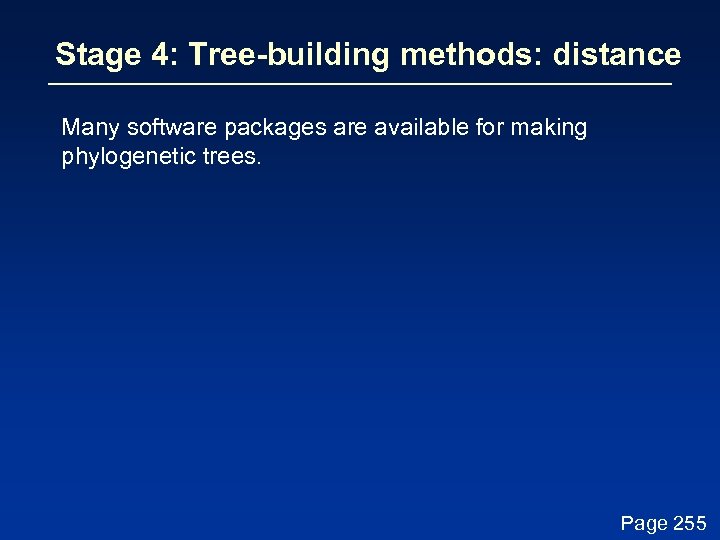
Stage 4: Tree-building methods: distance Many software packages are available for making phylogenetic trees. Page 255

Stage 4: Tree-building methods: distance Many software packages are available for making phylogenetic trees. We will describe two programs. [1] MEGA (Molecular Evolutionary Genetics Analysis) by Sudhir Kumar, Koichiro Tamura, and Masatoshi Nei. Download it from http: //www. megasoftware. net/ [2] Phylogeny Analysis Using Parsimony (PAUP), written by David Swofford. See http: //paup. csit. fsu. edu/. We will next use MEGA and PAUP to generate trees by the distance-based method UPGMA. Page 255
![How to use MEGA to make a tree [1] Enter a multiple sequence alignment How to use MEGA to make a tree [1] Enter a multiple sequence alignment](https://present5.com/presentation/541418e6165596e9dc4268f7517a81b6/image-104.jpg)
How to use MEGA to make a tree [1] Enter a multiple sequence alignment (. meg) file [2] Under the phylogeny menu, select one of these four methods… Neighbor-Joining (NJ) Minimum Evolution (ME) Maximum Parsimony (MP) UPGMA

Use of MEGA for a distance-based tree: UPGMA Click green boxes to obtain options Click compute to obtain tree
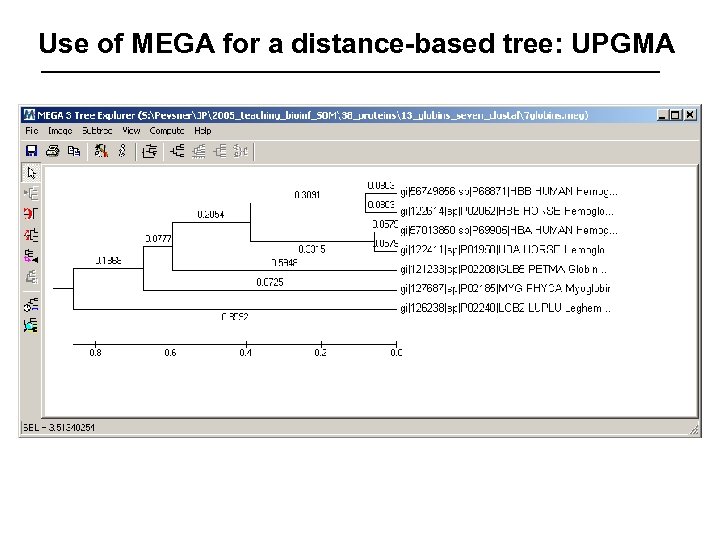
Use of MEGA for a distance-based tree: UPGMA

Use of MEGA for a distance-based tree: UPGMA A variety of styles are available for tree display

Use of MEGA for a distance-based tree: UPGMA Flipping branches around a node creates an equivalent topology
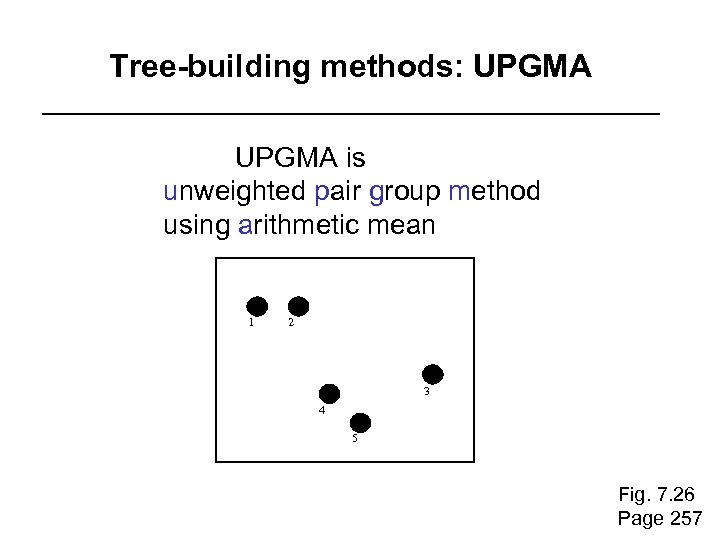
Tree-building methods: UPGMA is unweighted pair group method using arithmetic mean 1 2 3 4 5 Fig. 7. 26 Page 257

Tree-building methods: UPGMA Step 1: compute the pairwise distances of all the proteins. Get ready to put the numbers 1 -5 at the bottom of your new tree. 1 2 3 4 5 Fig. 7. 26 Page 257

Tree-building methods: UPGMA Step 2: Find the two proteins with the smallest pairwise distance. Cluster them. 1 2 6 3 4 1 2 5 Fig. 7. 26 Page 257
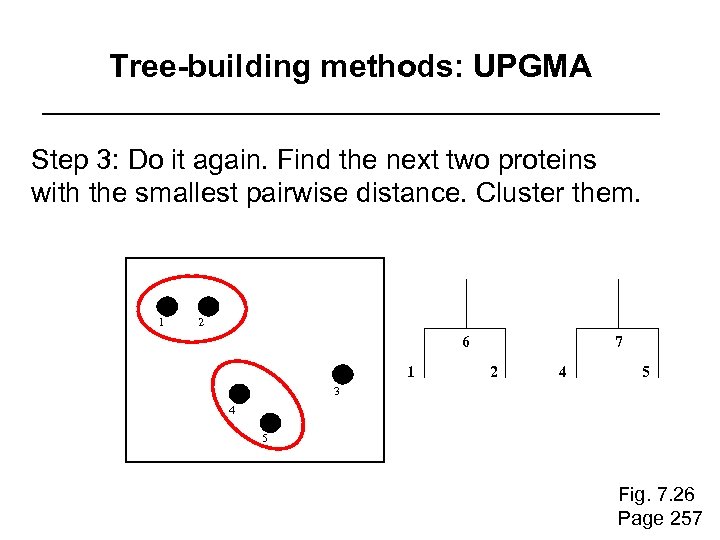
Tree-building methods: UPGMA Step 3: Do it again. Find the next two proteins with the smallest pairwise distance. Cluster them. 1 2 6 1 7 2 4 5 3 4 5 Fig. 7. 26 Page 257

Tree-building methods: UPGMA Step 4: Keep going. Cluster. 1 8 2 7 6 3 4 5 1 2 4 5 3 Fig. 7. 26 Page 257

Tree-building methods: UPGMA Step 4: Last cluster! This is your tree. 9 1 2 8 7 3 6 4 5 1 2 4 5 3 Fig. 7. 26 Page 257
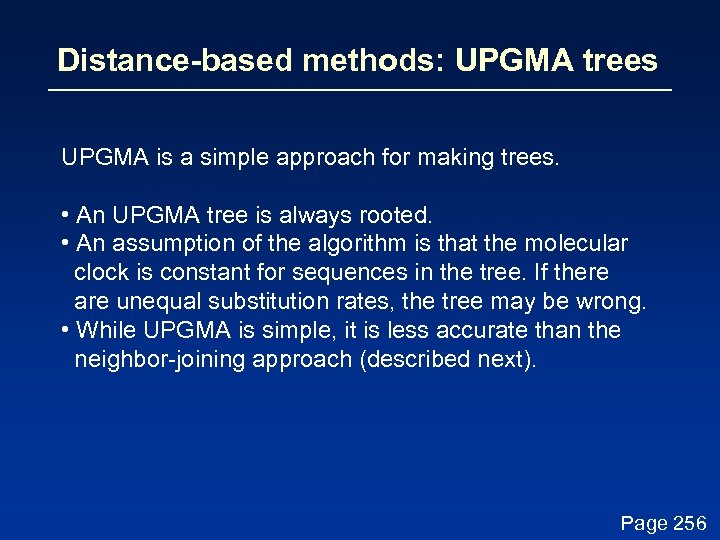
Distance-based methods: UPGMA trees UPGMA is a simple approach for making trees. • An UPGMA tree is always rooted. • An assumption of the algorithm is that the molecular clock is constant for sequences in the tree. If there are unequal substitution rates, the tree may be wrong. • While UPGMA is simple, it is less accurate than the neighbor-joining approach (described next). Page 256

Making trees using neighbor-joining The neighbor-joining method of Saitou and Nei (1987) Is especially useful for making a tree having a large number of taxa. Begin by placing all the taxa in a star-like structure. Page 259

Tree-building methods: Neighbor joining Next, identify neighbors (e. g. 1 and 2) that are most closely related. Connect these neighbors to other OTUs via an internal branch, XY. At each successive stage, minimize the sum of the branch lengths. Page 259

Tree-building methods: Neighbor joining Define the distance from X to Y by d. XY = 1/2(d 1 Y + d 2 Y – d 12) Page 259
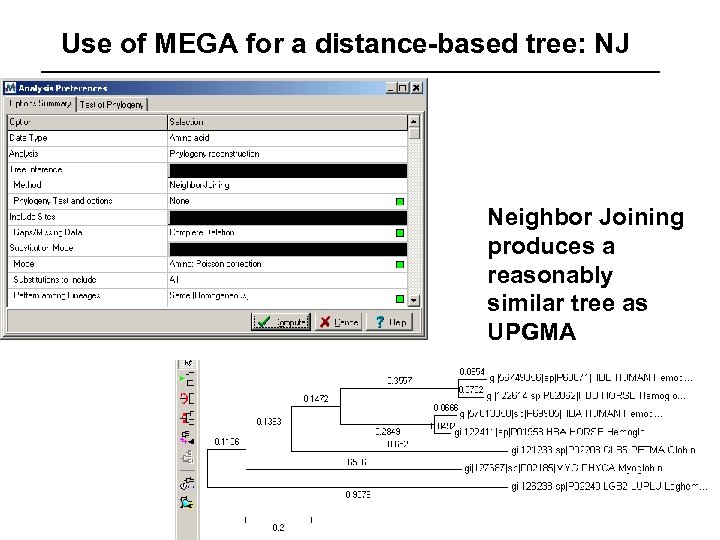
Use of MEGA for a distance-based tree: NJ Neighbor Joining produces a reasonably similar tree as UPGMA

Example of a neighbor-joining tree: phylogenetic analysis of 13 RBPs
![Stage 4: Tree-building methods We will discuss four tree-building methods: [1] distance-based [2] character-based: Stage 4: Tree-building methods We will discuss four tree-building methods: [1] distance-based [2] character-based:](https://present5.com/presentation/541418e6165596e9dc4268f7517a81b6/image-121.jpg)
Stage 4: Tree-building methods We will discuss four tree-building methods: [1] distance-based [2] character-based: maximum parsimony [3] character- and model-based: maximum likelihood [4] character- and model-based: Bayesian

Tree-building methods: character based Rather than pairwise distances between proteins, evaluate the aligned columns of amino acid residues (characters). Tree-building methods based on characters include maximum parsimony and maximum likelihood. Page 260

Making trees using character-based methods The main idea of character-based methods is to find the tree with the shortest branch lengths possible. Thus we seek the most parsimonious (“simple”) tree. • Identify informative sites. For example, constant characters are not parsimony-informative. • Construct trees, counting the number of changes required to create each tree. For about 12 taxa or fewer, evaluate all possible trees exhaustively; for >12 taxa perform a heuristic search. • Select the shortest tree (or trees). Page 260

As an example of tree-building using maximum parsimony, consider these four taxa: AAG AAA GGA AGA How might they have evolved from a common ancestor such as AAA? Page 261

Tree-building methods: Maximum parsimony AAA 1 AAA AAG AAA 1 1 AGA GGA AGA Cost = 3 AAA 1 AAG AGA AAA 2 AAA GGA Cost = 4 1 AAA 2 AAG GGA 1 AAA AGA Cost = 4 In maximum parsimony, choose the tree(s) with the lowest cost (shortest branch lengths). Page 261

MEGA for maximum parsimony (MP) trees Options include heuristic approaches, and bootstrapping
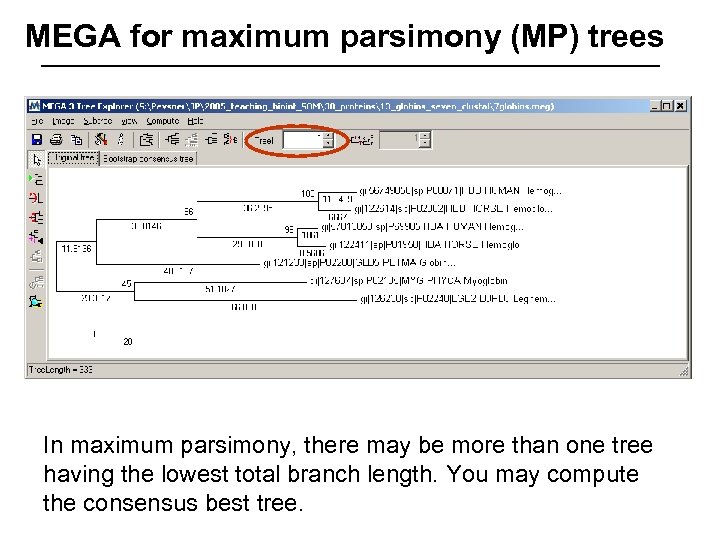
MEGA for maximum parsimony (MP) trees In maximum parsimony, there may be more than one tree having the lowest total branch length. You may compute the consensus best tree.

MEGA for maximum parsimony (MP) trees Bootstrap values show the percent of times each clade is supported after a large number (n=500) of replicate samplings of the data.

Phylogram (values are proportional to branch lengths)

Rectangular phylogram (values are proportional to branch lengths) Fig. 11. 22 Page 387

Cladogram (values are not proportional to branch lengths) Fig. 11. 22 Page 387

Rectangular cladogram (values are not proportional to branch lengths) These four trees display the same data in different formats. Fig. 11. 22 Page 387
![Stage 4: Tree-building methods We will discuss four tree-building methods: [1] distance-based [2] character-based: Stage 4: Tree-building methods We will discuss four tree-building methods: [1] distance-based [2] character-based:](https://present5.com/presentation/541418e6165596e9dc4268f7517a81b6/image-133.jpg)
Stage 4: Tree-building methods We will discuss four tree-building methods: [1] distance-based [2] character-based: maximum parsimony [3] character- and model-based: maximum likelihood [4] character- and model-based: Bayesian

Making trees using maximum likelihood Maximum likelihood is an alternative to maximum parsimony. It is computationally intensive. A likelihood is calculated for the probability of each residue in an alignment, based upon some model of the substitution process. What are the tree topology and branch lengths that have the greatest likelihood of producing the observed data set? ML is implemented in the TREE-PUZZLE program, as well as PAUP and PHYLIP. Page 262

Maximum likelihood: Tree-Puzzle (1) Reconstruct all possible quartets A, B, C, D. For 12 myoglobins there are 495 possible quartets. (2) Puzzling step: begin with one quartet tree. N-4 sequences remain. Add them to the branches systematically, estimating the support for each internal branch. Report a consensus tree.

Maximum likelihood tree

Quartet puzzling
![Stage 4: Tree-building methods We will discuss four tree-building methods: [1] distance-based [2] character-based: Stage 4: Tree-building methods We will discuss four tree-building methods: [1] distance-based [2] character-based:](https://present5.com/presentation/541418e6165596e9dc4268f7517a81b6/image-138.jpg)
Stage 4: Tree-building methods We will discuss four tree-building methods: [1] distance-based [2] character-based: maximum parsimony [3] character- and model-based: maximum likelihood [4] character- and model-based: Bayesian
![Bayesian inference of phylogeny with Mr. Bayes Calculate: Pr [ Data | Tree] x Bayesian inference of phylogeny with Mr. Bayes Calculate: Pr [ Data | Tree] x](https://present5.com/presentation/541418e6165596e9dc4268f7517a81b6/image-139.jpg)
Bayesian inference of phylogeny with Mr. Bayes Calculate: Pr [ Data | Tree] x Pr [ Tree ] Pr [ Tree | Data] = Pr [ Data ] Pr [ Tree | Data ] is the posterior probability distribution of trees. Ideally this involves a summation over all possible trees. In practice, Monte Carlo Markov Chains (MCMC) are run to estimate the posterior probability distribution. Notably, Bayesian approaches require you to specify prior assumptions about the model of evolution.
![Five stages of phylogenetic analysis [1] Selection of sequences for analysis [2] Multiple sequence Five stages of phylogenetic analysis [1] Selection of sequences for analysis [2] Multiple sequence](https://present5.com/presentation/541418e6165596e9dc4268f7517a81b6/image-140.jpg)
Five stages of phylogenetic analysis [1] Selection of sequences for analysis [2] Multiple sequence alignment [3] Selection of a substitution model [4] Tree building [5] Tree evaluation Page 266

Stage 5: Evaluating trees The main criteria by which the accuracy of a phylogentic tree is assessed are consistency, efficiency, and robustness. Evaluation of accuracy can refer to an approach (e. g. UPGMA) or to a particular tree. Page 266

Stage 5: Evaluating trees: bootstrapping Bootstrapping is a commonly used approach to measuring the robustness of a tree topology. Given a branching order, how consistently does an algorithm find that branching order in a randomly permuted version of the original data set? Page 266
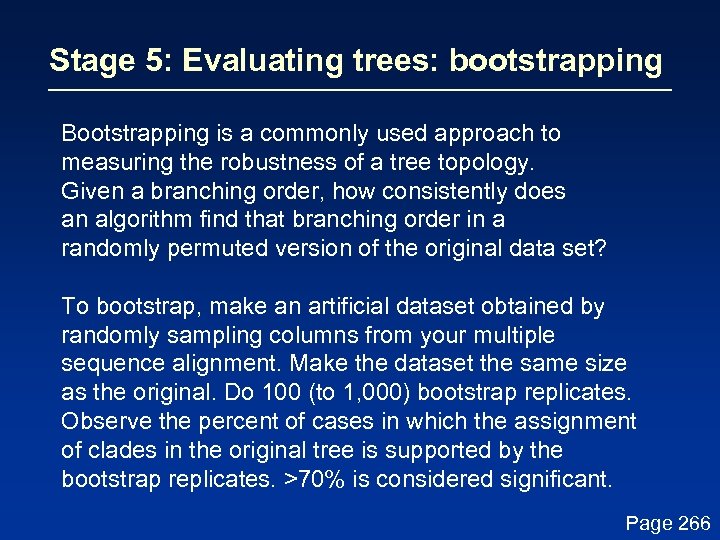
Stage 5: Evaluating trees: bootstrapping Bootstrapping is a commonly used approach to measuring the robustness of a tree topology. Given a branching order, how consistently does an algorithm find that branching order in a randomly permuted version of the original data set? To bootstrap, make an artificial dataset obtained by randomly sampling columns from your multiple sequence alignment. Make the dataset the same size as the original. Do 100 (to 1, 000) bootstrap replicates. Observe the percent of cases in which the assignment of clades in the original tree is supported by the bootstrap replicates. >70% is considered significant. Page 266

In 61% of the bootstrap resamplings, ssrbp and btrbp (pig and cow RBP) formed a distinct clade. In 39% of the cases, another protein joined the clade (e. g. ecrbp), or one of these two sequences joined another clade.
541418e6165596e9dc4268f7517a81b6.ppt